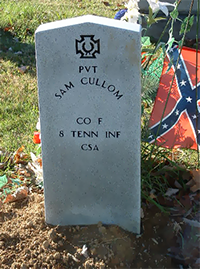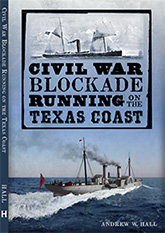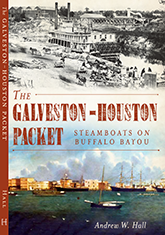More on Sam Cullom
As a follow-up to my recent post on Sam Cullom, a reader passes along this 2004 news item on a ceremony held at the cemetery in Livingston. From the Cookeville, Tennessee Herald-Citizen, July 17, 2004:

 Black Confederate soldier honored in ceremony Sam Cullom’s army service memoralized at Livingston
Black Confederate soldier honored in ceremony Sam Cullom’s army service memoralized at Livingston
A memorial service was held last Sunday at Livingston for a former slave who served as a soldier in the Confederate Army.
Descendants of Sam Cullom attended the ceremony, sponsored by the Highland Brigade of the Sons of Confederate Veterans and the Sally Tompkins chapter of the United Daughters of the Confederacy, at the Bethlehem Methodist Church, near the Overton County Fairgrounds. Keynote speaker was Ed Butler of Cookeville, commander of the Tennessee Division of the SCV.
At the outbreak of the War Between the States, Sam Cullom was a slave belonging to Alvin Cullom who lived in Overton County.
Sam and Alvin’s son, Jim, joined the 25th Tennessee Infantry and served with the Army of Tennessee at battles in Kentucky, Tennessee and Georgia.
At the battle of Atlanta, Jim was killed in action, and Sam buried him. Sam then was granted leave and brought home to Overton County the personal effects of the young soldier. Sam then joined the 8th Tennessee Cavalry and served through the rest of the war.
The exact spot where Sam Cullom is buried in the Bethlemen cemetery is lost to history.
Cullom’s early story sketchy because of poor records keeping of the day, but he stated in his Confederate pension application that he had been born in Maryland.
Overton County Historian Ronald Dishman said he suspects that Alvin Cullom, a judge and member of Congress, bought Sam from George and William Cullom, tobacco farmers who came from Maryland.
Congressman Cullom’s family lived near Monroe, north of Livingston, but in later years moved to the Bethlehem area, off what is now Hwy. 84, between Monterey and Livingston.
Sam Cullom’s Confederate pension application indicates that he came to Tennessee when he was about 9-years old.
There had been a Bethlehem Methodist congregation since around 1801, Oprha Hassell, church historian, said, but Alvin Cullom gave land to build the church and lay out a cemetery were it now stands. The large cemetery adjacent to the church is where the Cullom family, both white and black, including the congressman and his slave, Sam, are buried.
Congressman Cullom was a part of a peace delegation that tried to avert the tragic War Between the States but to no avail. When war did break out, Sam was sent away to the Confederate army with Alvin Cullom’s sons, Jim and Ras.
Sam, long with Jim and Ras, served in the 8th Infantry Regiment of the Confederate States of America. They were assigned to Capt. Calvin E. Myer’s Co. D, which later became Co. F. James Cullom eventually became captain of that company.
Mustered into Confederate service on July 31, 1861, at Big Springs, Va., the 8th Infantry subsequently took part in the Cheat Mountain Campaign; fought at Corinth, Miss.; at Munfordville and Perryville, Ky.; and at Murfreesboro, Chickamauga and Missionary Ridge in Tennessee.
After the war, Sam returned home and described for the Alvin Cullom family how their son, Capt. Jim Cullom, was killed in the Atlanta fighting, telling them how it was he who had buried their son.
It wasn’t until 1921, when Sam was around 80-years old, that he applied for a Confederate pension after the Tennessee General Assembly passed the “Negro Pension Law.” By then, he had seven children and several grandchildren, and he and wife were living in the home of their son, Mack, a noted blacksmith of the Livingston area.
It is not known how many African American served as Confederate soldiers but it is clear that the Confederate Army did include blacks, even those listed as “free men of color,” within their ranks.
“Because the North won the war,” Ed Butler said in his address, “they got to write the history books. They would have you believe that all the blacks in the Confederate Army were cooks or valets.”
Butler gave an example of a White County Confederate soldier, Churchwell Randals, who was black and who attained the rank of corporal. “You wouldn’t attain that rank by being a cook or a valet,” he said.
“Slavery was an abomination which should have been done away with many years before it was,” Butler said. He pointed out a fact, omitted from some history books, that even Union Gen. Ulysses S. Grant had slaves — and he didn’t free them until Dec. 1865, after the 13th Amendment to the Constitution was passed, several months after the war had ended.
One of Sam Cullom’s descendants, Dr. Althea Armstrong, Sam Cullom’s great-granddaughter from Detroit, Mich., also spoke at the memorial service.
“This is an historical moment in America,” she said. “Where I come from, the population is 90-percent black. Here, it is 98-percent white. But here we are. It is not a black thing or a white thing. Today it is about freedom.”
![]()
What should we make of this? What parts of Sam Cullom’s story changed between this news item in 2004, and the one four years later? Are different claims made, and how does either square against the contemporary historical record? Are there themes or arguments in this story we’ve heard before?
___________






I took a look at the CW service records for the CSA’s 8th Tenn Inf as found at Fold3.com (NARA M628, roll 0150).
The “Ras” Cullom in the article above is presumably soldier Erasmus E. Cullom. His 8th Tenn Inf. file runs to 26 images. There is also a single index card image for a variant spelling of his name, indicating that E. E. Cullum is filed with E. E. Cullom.
His brother Jim Cullom is presumably soldier James J. Cullom. His 8th Tenn Inf file has 29 images.
There is no file for anyone else in the regiment named Cullom, Cullum, or any similar variant.
I did not find any mention of “Sam” or “Sam Cullom” in the service records of James or Erasmus.
For that matter, I did not find in James’s and Erasmus’s files any reference to “servant,” “slave,” “colored,” or any other typical race-identifying words of the period.
Reed-Did you find anything on Churchwell Randals?
Didn’t look. But now that you mention it, I’ll see what I can find.
BTW, has anyone see Sam Cullom on the 1870 census? I can’t find him anywhere (and that includes trying a variety of variant-spelling and other boolean searches at ancestry.com and other places).
I didn’t, but he might have been living elsewhere, or recorded with a very alternate spelling.
Yeah, what is it with southern name spelling. I mean, we all find variant spellings in our research, but seriously, my southern kin find more ways to spell simple names… (and don’t get me started on the whole nickname thing. See “Ras” for “Erasmus” in the earlier Sam Collum post.)
Anyway, at the request of fellow reader Blough, I went looking for records of Churchwell Randals (see the original article, above), supposedly an African-American from White County, TN, who served as a Corporal in the CSA. According to sources, White Co. was on the border between pro-union eastern TN and pro-southern middle TN and was the site of partisan guerilla skirmishes during the war.
The 1860 census has RANDELS, Churchill (or Churchwell—handwriting is poor) in District 13, White Co., Tennessee. Roll: M653_1279; Page: 103; Image: 213; Family History Library Film: 805279 (ancestry.com). This man was 30 years old and a laborer, living with his presumed parents and siblings. It is interesting to find this black family enumerated as part of a white family (that of Mary Williams) and among otherwise white neighbors.
Among Churchwell’s presumed siblings (?, or at least they share the Randels surname on the 1860 census are Samuel, age 25 and Mongomery, age 21 (?).
A Google search on Churchwell’s name (and variante) produced a few hits for unsourced articles, one of which included this helpful detail:
“Churchwell Randalls, another free man of color from White County, also joined the 25th Tennessee Infantry at Camp Myers.” (Crossville Chronicle online, 25 Feb. 2008)
At Fold3.com the records of the 25th Tennessee includes brief complied service records for two Free Men of Color with similar surnames:
• Churchwell Randalls (aka Churchwell Randles) of Co. C in 1861
• Stephen Randals (aka Stephen Randles) of Co. A in 1861
Unlike the white members of the 25th, these men have no “rank in” or “rank out” indicated on their compiled service documents. My best guess would be they “signed up” but were not counted as fighting men.
And just to make things more interesting, in 1864-66 one Montgomery Randals is recorded as 1st Sgt (later reduced in rank to Pvt.) of Co. E, 15th Regt., U.S.C.T. (Compiled military service records of volunteer Union soldiers who served with the United States Colored Troops, infantry organizations; Microfilm Serial: M1822; Microfilm Roll: 27)
There is more to be gleaned from these documents and others, and I may take them up later. But it’s late, so that’s it for now.
I see they’re resurrecting the myth that Ulysses Grant had slaves (in the plural) and that he didn’t free them until forced to by the 13th Amendment. In the first place, as has been said before, even if it was true, it was not relevant since Grant played no role in the secession debates and his loyalty was firmly with the Union. The same can be said of the slave states that remained loyal to the Union. However, Grant had 1 slave, William Jones, who he acquired, somehow, from his father-in-law Frederick Dent, who did own multiple slaves, approximately in 1858. Grant freed Jones on March 29, 1859 at a time when Grant, who badly needed money at that point, could have made a great deal of money by selling Jones (look at 1850s slave prices. They were staggering. Pollock estimates Grant could have obtained $1000-1500 for selling Jones). Jones was 35) or at steady income by leasing him out. Bob Pollock’s “Yesterday. . . and Today” has a good discussion of this, including the manumission papers in Grant’s own hand. The comment from Brooks Simpson gets into the origins of the claim that Grant owned more. Brooks also deals with it in his “Crossroads” blog in http://cwcrossroads.wordpress.com/2011/01/18/race-and-slavery-north-and-south-some-logical-fallacies/
Yep. It’s a common deflection used by the heritage crowd.
Observing that U.S. Grant was a slave-owner is an excellent way to emphasize the extraordinary hypocrisy of the Unionists, but it also emphasizes the full measure of northern guilty participation in American slavery. By focusing on a high profile figure like Grant, it also serves as a more general reminder that slavery was perfectly legal in Missouri, Maryland, Delaware, West Virginia, and Kentucky. Accordingly, we are more specifically reminded that all the abuses attendant upon slavery and laid at the feet of Confederates, are also laid at the feet of Unionists. Even more specifically, we are reminded that the northern states were enthusiastically and fully complicit in supporting slavery, as the sugar, tobacco, cotton, indigo and rice not only filled northern warehouses, mills, and shops, but the profits also handsomely filled northern pocketsbooks.
What have you found about Sam Cullom?
Clarissa-And your point is?
.
I assume that that question is directed toward M.D. Blough.
It was directed you you, since your comment was to the thread, not to her.
As she points out, Grant owned one slave in his lifetime, whom he manumitted (at not inconsiderable personal expense to himself) after a few months. The reference to ties to slavery in the North in the news story, and in your comment, is another deflection. It wasn’t especially relevant to telling Sam Cullom’s story in 2004, nor is it now.
The point, however, was that her comments had nothing to do with Sam either, but were made in direct response to the photograph, which you, and not I, posted. I also commented on the photograph’s implications, but you delibertely chose to ask me, and not her, about Sam. Why?
It seemed like a reasonable question.
Hey Andy,
Thanks for this great information. I haven’t done a simple Google search for awhile, and I wish I had known about the ceremony and headstone in order to go down to Tennessee and be there for that occasion.
I’m James J. Cullom’s g’g’g-grandson, and he was killed in Atlanta on 22 July 1863, leading Co. F of the 8th Tennessee Infantry. Family legend had it that Sam came home to Livingston with his account book, watch, and sword, and that he was sent back with gold to bury James. (The account book contains a later note by James’ father that he came up with $50 in Confederate money “for James’ coffin.”) I’ve been through that big Confederate cemetery in Atlanta, but am unable to find his burial place. It may have been impossible to find him in the wake of the disaster of the battle.
James was the son of the former Congressman and Livingston-area jurist Alvan Cullom, who is buried in Livingston. James is also a first cousin of Illinois governor and senator Shelby Moore Cullom, whose father had emigrated to Illinois many years before the War and served in the state legislature with Lincoln.
James was the Sergeant Major of the 8th TN at the start of the War, and in the reorganization of the Confederate Army in the spring of ’62, he was elected captain of Company F. His brother Erasmus (“Ras”) was one of his lieutenants. James was slightly wounded at Chickamauga (per the OR), and his regiment was badly mauled at Murfreesboro (Stones River), where Colonel Moore was killed. The visitor’s center at the battlefield has a cannon with a plaque inscribed to Moore’s valor.
Capt. Cullom left, in addition to his account book, a muster roll of the company which I believe to be from around the time of the Murfreesboro fight, as it seems to show a large number of men absent from the ranks on the right-hand side of the roll. Neither James, nor Erasmus, nor their brother Alvan J (with the 4th (Murray’s) TN Cavalry) survived the War. Alvan J. Cullom is buried under a crudely-inscribed headstone next to his parents at Bethlehem Cemetery in Livingston. The cemetery has a number of Culloms in it; fittingly, at this distance in time and under those headstones, you can’t tell which are white and which are black.
James J. Cullom and his wife, Kate Cumings, had three children. I am descended from their only daughter, born in 1860, who pioneered Montana.
Thank you Sir. I am the great grand daughter of Sam Cullom. It’s good to know that you are acknowledging Sam Cullom and his honorable behavior in the war. All the Culloms, black and white, buried side by side is evidence of the honor and respect that was shared by the entire family. God Bless You!!
Ms. Yellowe,
I would love to hear any stories and details your family might have passed down about Sam and his time in the War. I think my family would find that very interesting. Certainly it’s something we haven’t paid as much attention to as we should have.
I have a hand written letter, obtained from the Tennesee State Library and Archives, where his “master”, Captain Myers and the grandaughter of his “master”, validates that he served in the Confederacy. They refereed to him as a darkey that they have known for a long time and are assisting him with his pension because it is a deserving case. I spoke to a Cullom, descendant who validated the story of Sam bringing the body of son of his “master” off the battlefield. She said he was more like a part of the family. I don’t think the descendants of James Cullom, Rebecca Pinched and Salk Tompkins, would have allowed my cousin Althea Armstrong to stand with them in honor of Sam Cullom at his grave site locared on the Bethlehem Methodist Church Cemetery in July 2004 if the sorry were not true. Thanks for your sense if fairness in agreeing that some of our forgotten heroes deserve to be honored
I have a hand written letter, obtained from the Tennesee State Library and Archives, where his “master”, Captain Myers and the grandaughter of his “master”, validates that he served in the Confederacy. The letter.was.addressed.to Hon. John P. Hickman and signed by J.H. Lea.They refereed to him as a darkey that they have known for a long time and are assisting him with his pension application because it is a deserving case. I spoke to a Cullom descendant who validated the story of Sam bringing the body of the son of his “master” off the battlefield. She said he was more like a part of the family. I don’t think the descendants of James Cullom, Rebecca Pinched and Salk Tompkins, would have allowed my cousin Althea Armstrong to stand with them in honor of Sam Cullom at his grave site locared on the Bethlehem Methodist Church Cemetery in July 2004 if the story were not true. Thanks for your sense if fairness in agreeing that some of our forgotten heroes deserve to be honored.
I have a hand written letter, obtained from the Tennesee State Library and Archives, where his “master”, Captain Myers and the grandaughter of his “master”, validates that he served in the Confederacy. The letter.was.addressed.to Hon. John P. Hickman and signed by J.H. Lea.They refereed to him as a darkey that they have known for a long time and are assisting him with his pension application because it is a deserving case. I spoke to a Cullom descendant who validated the story of Sam bringing the body of the son of his “master” off the battlefield. She said he was more like a part of the family. I don’t think the descendants of James Cullom, Rebecca Pincheon and Sally Tompkins, would have allowed my cousin Althea Armstrong to stand with them in honor of Sam Cullom at his grave site locared on the Bethlehem Methodist Church Cemetery in July 2004 if the story were not true. Thanks for your sense if fairness in agreeing that some of our forgotten heroes deserve to be honored.
Did you get the entire pension file? I have a PDF of it somewhere. He must have been in his 80s when he made that application.
Cullom’s pension file is here:
Click to access cullompensionfile.pdf
Thanks, Andy. I knew I had the link somewhere. Jim Cullom, mentioned in the file as Sam’s Confederate soldier master, was my 3-g grandfather.
I am Dr. Althea Armstrong, great great granddaughter of Sam Cullom, who was stolen from Cuba when he was 9 years old, by Cong. Alvan Cullom. On the eve of the War, Cong. Cullom, a Democrat, led a Peace Party to Washington, D.C., although he was a slave trader. We have several reasons to believe he backed Sam as a conductor on the Underground Railroad, because Sam traveled freely before, during, and after the War. By 1888, he’s living both in Detroit as a machinist, and also in Overton County where his son, Mack owned over 1,200 acres of land by 1902. Blacks are not a monolithic people, and a great deal has been stolen from us, as I noted when I spoke to those who honored my ancestor. Much more happened to Sam than any outsider can be privy to. Its best said, he was a great man whose enslavement, I hope, will continue to impress upon the people of Overton County, that, ‘freedom is never free’.